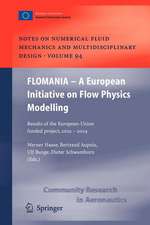Progress in Computational Flow-Structure Interaction: Results of the Project UNSI, supported by the European Union 1998 – 2000: Notes on Numerical Fluid Mechanics and Multidisciplinary Design, cartea 81
Editat de Werner Haase, Vittorio Selmin, Bengt Winzellen Limba Engleză Paperback – 9 dec 2010
| Toate formatele și edițiile | Preț | Express |
|---|---|---|
| Paperback (1) | 1220.88 lei 6-8 săpt. | |
| Springer Berlin, Heidelberg – 9 dec 2010 | 1220.88 lei 6-8 săpt. | |
| Hardback (1) | 1224.99 lei 6-8 săpt. | |
| Springer Berlin, Heidelberg – 14 noi 2002 | 1224.99 lei 6-8 săpt. |
Din seria Notes on Numerical Fluid Mechanics and Multidisciplinary Design
- 18%
 Preț: 1224.36 lei
Preț: 1224.36 lei - 18%
 Preț: 1818.79 lei
Preț: 1818.79 lei - 18%
 Preț: 1115.46 lei
Preț: 1115.46 lei -
 Preț: 413.66 lei
Preț: 413.66 lei -
 Preț: 413.07 lei
Preț: 413.07 lei -
 Preț: 413.84 lei
Preț: 413.84 lei - 18%
 Preț: 1232.26 lei
Preț: 1232.26 lei - 18%
 Preț: 1220.45 lei
Preț: 1220.45 lei - 24%
 Preț: 1044.04 lei
Preț: 1044.04 lei - 18%
 Preț: 1229.91 lei
Preț: 1229.91 lei - 18%
 Preț: 1224.36 lei
Preț: 1224.36 lei - 18%
 Preț: 1215.35 lei
Preț: 1215.35 lei - 18%
 Preț: 1222.80 lei
Preț: 1222.80 lei - 18%
 Preț: 1218.38 lei
Preț: 1218.38 lei - 18%
 Preț: 1223.55 lei
Preț: 1223.55 lei - 18%
 Preț: 1223.55 lei
Preț: 1223.55 lei -
 Preț: 411.93 lei
Preț: 411.93 lei - 18%
 Preț: 1832.22 lei
Preț: 1832.22 lei - 18%
 Preț: 1825.92 lei
Preț: 1825.92 lei - 18%
 Preț: 1225.94 lei
Preț: 1225.94 lei - 18%
 Preț: 1212.53 lei
Preț: 1212.53 lei - 18%
 Preț: 1222.45 lei
Preț: 1222.45 lei - 18%
 Preț: 1830.17 lei
Preț: 1830.17 lei - 18%
 Preț: 948.92 lei
Preț: 948.92 lei -
 Preț: 387.38 lei
Preț: 387.38 lei - 18%
 Preț: 1213.61 lei
Preț: 1213.61 lei - 18%
 Preț: 1243.29 lei
Preț: 1243.29 lei - 18%
 Preț: 952.09 lei
Preț: 952.09 lei
Preț: 1220.88 lei
Preț vechi: 1488.88 lei
-18% Nou
Puncte Express: 1831
Preț estimativ în valută:
233.69€ • 253.92$ • 196.43£
233.69€ • 253.92$ • 196.43£
Carte tipărită la comandă
Livrare economică 21 aprilie-05 mai
Preluare comenzi: 021 569.72.76
Specificații
ISBN-13: 9783642078682
ISBN-10: 3642078680
Pagini: 384
Ilustrații: X, 374 p.
Dimensiuni: 155 x 235 x 20 mm
Greutate: 0.54 kg
Ediția:Softcover reprint of the original 1st ed. 2003
Editura: Springer Berlin, Heidelberg
Colecția Springer
Seria Notes on Numerical Fluid Mechanics and Multidisciplinary Design
Locul publicării:Berlin, Heidelberg, Germany
ISBN-10: 3642078680
Pagini: 384
Ilustrații: X, 374 p.
Dimensiuni: 155 x 235 x 20 mm
Greutate: 0.54 kg
Ediția:Softcover reprint of the original 1st ed. 2003
Editura: Springer Berlin, Heidelberg
Colecția Springer
Seria Notes on Numerical Fluid Mechanics and Multidisciplinary Design
Locul publicării:Berlin, Heidelberg, Germany
Public țintă
Professional/practitionerCuprins
I The UNSI Project.- II Technical, partner—related reports containing method descriptions and concise presentation of important results.- III Summary of work carried out in the main tasks of the UNSI project.- IV Application–oriented synthesis of work.- V Conclusion and lessons learnt.- VI References.
Textul de pe ultima copertă
This volume contains results gained from the EU-funded, 4th Framework project, UNSI (Unsteady Viscous Flows in the Context of Fluid-Structure Interaction). 15 European organisations, industry, research, and universities, have collaborated on the topic of non-linear, static and dynamic aeroelasticity applications with some special emphasis on the improvement of CFD methods applied to unsteady flow. Hence, the book is split into five main parts. Presented are a project description (with points of contact for the interested reader), summaries of work performed by each partner, summaries of work carried out in the work tasks, an application-oriented synthesis, and last but not least a section with conclusions and lessons learnt.
Caracteristici
State of the art in computational fluid dynamics and nonlinear aeroelasticity Includes supplementary material: sn.pub/extras























